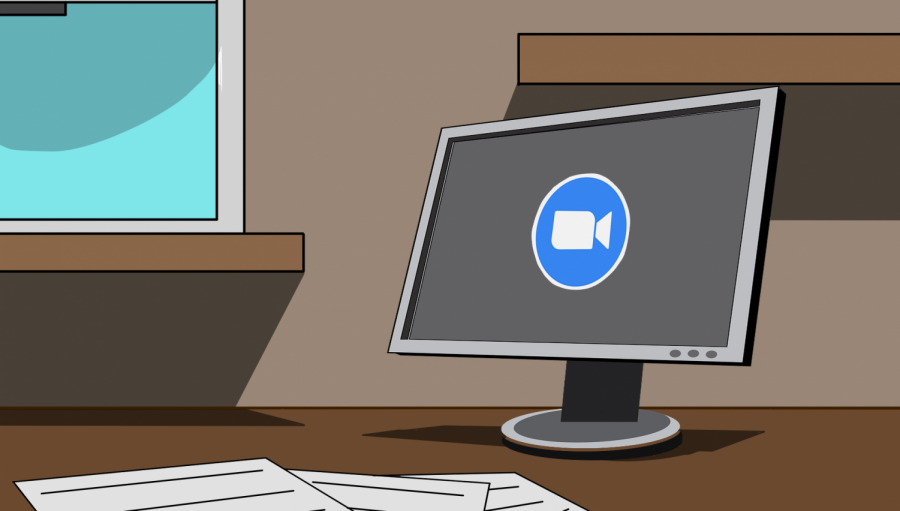Teachers’ views on remote learning: How it’s changed their career
A computer with the Zoom logo on the screen of it.
October 5, 2020
There are many opinions among the public about how remote learning is inferior to classroom instruction. Parents, community members, as well as students have been nothing short of vocal about their concerns regarding remote learning and its ability to effectively teach their children. Teachers of those students also have their own viewpoints on this pandemic, and how it’s changing their job in unseen ways.
Despite engaging in the remote learning plan, teachers are not in love with it. The plan isn’t perfect and still forces change for the teachers who use it, and the difficult part of it all is that all teachers don’t have an equal grasp of how to set up their classes online. Delaney Geraghty, a Spanish teacher at RB, has comments on how this makes for a troublesome experience for students.
“Obviously every teacher’s different so it’s probably a big challenge for students to adapt to all that even in normal school, but online it’s probably more challenging but there are lessons like ‘Essential Tips On How To Survive The New Education Norm‘ which can help teachers understand the system better” Geraghty said. “Every teacher here at RB is at different levels of comfortability with technology, so what I’m able to do might not be what another teacher is able to do, or they are able to do things in a more efficient way than I am, so I think that’s a big challenge for students too.”
This doesn’t just apply to the organizing classes over Zoom, this goes for hands-on instruction as well. When in a home environment it’s more difficult to do things like gym workouts, but it’s especially hard for teachers in the science department. Due to their classes not only having an instruction portion of their class, but also the experiment portion in which they do labs with their students. Since everybody is at home, they don’t get to do those types of experiments on their own anymore. Sam Weiss, a physics teacher at RB, talks about how it’s affected how he teaches his students.
“In physics, we rely heavily on labs to further our understanding of concepts we’re talking about, but also to bridge the gap between theory and what’s actually happening,” Weiss said, “We have so many awesome, cool demos that we do, we had one where we throw a watermelon off the roof, we have other ones that we do all the little brain teasers that always get people every year… you lose a little bit of it [the charm] by trying to do it virtually.”
In classrooms, there is a lot of small talk and jokes that are made whilst class is going on. They may seem like just short term, minute distractions from a long lecture, but these small things pile up into what makes a class enjoyable to the kids who are part of it. Sometimes that can lead to a more participative class in the long run. However, due to the mute button and disable camera features in Zoom, teachers are finding it a lot harder to get participation from their students. Weiss says that it’s hard to gauge a student’s understanding to a topic because of this.
“It’s really hard to tell where a student is at teaching remotely because you can’t see them. Kids don’t have to have webcams on, they technically don’t have to participate in class unless participation is part of your class,” Wess said, “When kids are struggling in class they are a lot more inclined, when you walk up to them and talk to them, to work on that and help them out,”
However, don’t take it as if teachers only have gripes over remote learning. There are some upsides that teachers like, for example, online tests are much better for teachers in terms of grading things at a quicker pace, and students benefit from that as a result.
“Retakes are a lot better online just given the fact that kids can immediately see their progress on these quizzes and tests and know exactly where they’re at in that moment,” Weiss said, “If we were in school and I gave you something like that on paper it would probably take me a week to get it back to you.”
If it wasn’t enough to have to run synchronized classes on Zoom, teachers also have to run after school Zooms called “Office Hours,” which allows students to come in and get help on assignments that they are puzzled by. Though it sounds like a great opportunity to take advantage of, most students don’t jump at it, and the ones that would ultimately benefit from it are already tired after seven hours in front of a screen and doing online assignments.
“I have more students coming in for little, small questions that I don’t think they would stop by after school and just ask,” Geraghty said, “If one student comes in it’s better because sometimes a lot of people come in and it’s hard to focus and help them all at once.”
People are cognizant of the problems presented with the remote learning model, and it seems in some of those problems, teachers can agree. However, in these trying times, it’s the safest mode of learning that we have available to us, and we shouldn’t trash it before we’re sure it’s safe enough to return to in-person learning.



